Abstract
Mesoporous carbon aerogels (MCA) synthesized via aqueous polymerization of resorcinol and formaldehyde were modified by copper chloride and applied for adsorption removal of elemental mercury (Hg0) at a low temperature. The sorbents were characterized by field emission scanning electron microscopy (FESEM), X-ray diffraction (XRD), nitrogen adsorption/desorption isotherms, and X-ray photoelectron spectroscopy (XPS) techniques. The results show that CuCl2-modified MCA exhibited good ability for Hg0 adsorption in the 40–160 °C temperature range, with Hg0 removal efficiency all above 95.0%. The Hg0 removal efficiency first increased and then decreased with the elevation of reaction temperature. It performed optimally at 80 °C with the highest Hg0 removal efficiency of 98.7%. XPS results indicate that covalent chlorines (C-Cl groups) play an important role in elemental mercury adsorption process. Hg0 is firstly captured in the form of oxidized mercury (Hg2+) and then reacts with C-Cl groups to form HgCl2.
1. Introduction
Mercury is one of the most toxic heavy metal elements in the environment due to its high volatility, long persistence, and strong bioaccumulation property [1]. Coal-fired power plants are the dominant anthropogenic mercury emission sources [2]. Elemental mercury, oxidized mercury, and particle-bound mercury are three types of mercury species in flue gas [3]. On account of its low aqueous insolubility and high vaporability, elemental mercury (Hg0) capture from flue gas is considered the hardest and most urgent work in the mercury emission control of coal-fired power plants [4].
Adsorption removal of elemental mercury by using solid sorbents is a viable method with respect to mercury emission control of coal-fired power plants [5]. Enormous carbon-based or noncarbon-based materials, e.g., biomass-derived chars [6], activated carbon [7], fly ash [8], as well as natural minerals [9], had been extensively studied for elemental mercury removal from flue gas. However, most of them exhibit limited mercury adsorption capacity and poorer Hg0 removal efficiency at low temperatures under flue gas free of HCl [10]. Carbon aerogels consisting of interconnected and uniform particles with well-defined pore architectures are promising sorbents for elemental mercury capture [11]. The large surface area and high porosity of carbon aerogels could offer abundant active sites for Hg0 adsorption and benefits a mass transfer process (e.g., Hg0 vapor diffusion) [12]. CuCl2-modification is found to be effective for mercury adsorption, and the chlorine ions contained in CuCl2 are favorable for Hg0 oxidation in chlorine-free flue gas [13]. In addition, CuCl2 possesses the advantage of lower capital cost compared with the commonly used metal oxide additives. Yang et al. [14] developed a CuCl2-modified magnetosphere for elemental mercury removal. It performed optimally at 150 °C with the highest Hg0 removal efficiency of 90.6%. Zhou et al. [15] synthesized a CuCl2-impregnated CeO2-ZrO2 sorbent for Hg0 removal in chlorine-free coal combustion flue gas. They revealed that the interaction between Cl and chemical adsorbed oxygen contributed to its superior and stable mercury capture performance with a Hg0 removal efficiency of 89.6–97.1%. Therefore, CuCl2 is employed as the additive for carbon aerogels for the sake of combining the prominent oxidation ability of CuCl2 and the good mass transfer ability of carbon aerogels toward elemental mercury adsorption.
In this work, mesoporous carbon aerogels (MCA) with large pore volume (>1 cm3/g) and large specific surface area (>500 m2/g) were synthesized via the sol-gel method. The as-prepared MCA was subsequently modified with CuCl2 by using the pore volume impregnation approach for Hg0 adsorption at an upflow bench-scale fixed-bed reactor in the temperature range of 40–160 °C. The samples were characterized by using field emission scanning electron microscopy (FESEM), X-ray diffraction (XRD), nitrogen adsorption/desorption, and X-ray photoelectron energy spectroscopy (XPS) techniques. The effects of CuCl2 concentration and reaction temperature on Hg0 adsorption performances of CuCl2-modified MCA were investigated. Furthermore, the reaction mechanism of Hg0 capture over CuCl2-modified MCA is also addressed according to the XPS analysis results. Cu06MCA, Cu18MCA, and Cu30MCA denote the MCA modified by CuCl2 with molar concentrations of 0.06, 0.18, and 0.30 mol/L, respectively.
2. Results and Discussions
2.1. Characterization Analysis
The FESEM images of pristine and CuCl2-modified MCA are shown in Figure 1. The as-prepared MCA was formed by interconnected irregular spherical particles (Figure 1a), and many pores were produced among the particles which aggregated together. After modification with cupric chloride, the surface of the MCA became a little bit compact, and the MCA particles cohered together (Figure 1b), probably leading to the reduction of the Brunauer-Emmett-Teller (BET) surface area (Table 1).
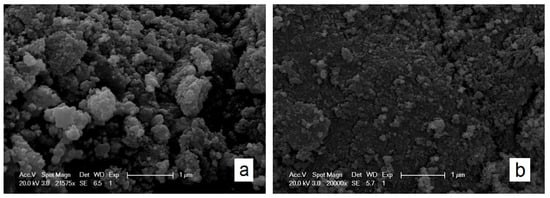
Figure 1.
Field emission scanning electron microscopy (FESEM) images: (a) Mesoporous carbon aerogels (MCA) and (b) Cu18MCA.

Table 1.
Textural property of pristine and CuCl2-modified MCA.
The XRD patterns of pristine and CuCl2-modified MCA are presented in Figure 2. The bigger broad diffraction peaks at ~23.9° were assigned to the reflection of the (002) lattice plane of activated carbon and graphite. The smaller broad diffraction bands at ~43.6° were attributed to the reflection of the (100) lattice plane of graphite [16,17]. The signals of CuCl2 were not detected in CuCl2-modified MCA, probably owing to the smaller content of CuCl2 or the thorough dispersion of amorphous CuCl2 on the MCA surface.
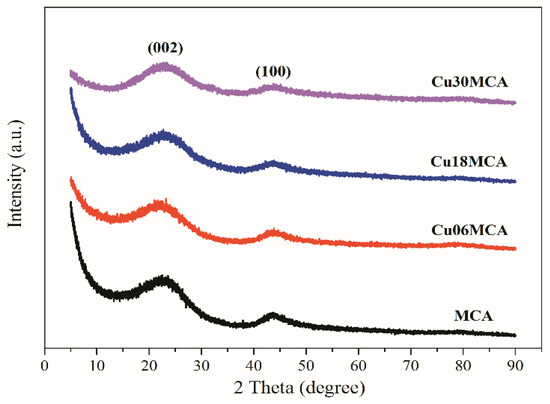
Figure 2.
X-ray diffraction (XRD) patterns of pristine and CuCl2-modified MCA.
The nitrogen adsorption–desorption isotherms and pore size distributions of pristine as well as CuCl2-modified MCA are displayed in Figure 3. The MCA exhibited type IV isotherm (Figure 3a). The position of the hysteresis loop at the higher relative pressure of above 0.8 implies the presence of large mesopores on the MCA surface [18], which is consistent with the broad pore size distribution centered between 10 and 30 nm. The BET surface area, total pore volume, and pore diameter of the MCA were 523 m2/g, 1.21 cm3/g, and 9.2 nm, respectively (Table 1). After modifying with CuCl2, the mesoporous structures of the MCA were still preserved. However, the pore size distribution became narrow, with pore diameter centered at ~16 nm (Figure 3b).
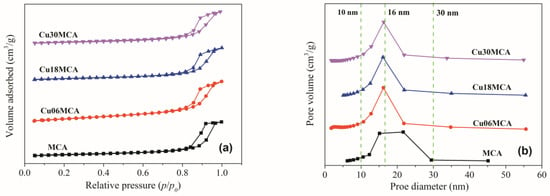
Figure 3.
(a) Nitrogen adsorption–desorption isotherms and (b) pore size distributions of pristine and CuCl2-modified MCA.
The XPS spectra of fresh and spent Cu18MCA are displayed in Figure 4 to determine the surface species on sorbent surfaces. The C 1s spectra can be deconvoluted into five components in which chemical shifts are assigned to carboxyl groups (~288.6 eV), C=O bonds (~287.0 and ~287.2 eV), C-OH groups (~285.4, ~285.6, and 286.2 eV), and graphitic carbon (sp2 configuration: ~284.2 and ~284.8 eV) [18]. In addition, the broad band at ~290.0 eV is related to shake-up satellite peaks assigned to π–π* transitions in aromatic rings [19]. The Cu 2p peak of fresh Cu18MCA at ~935.8 eV is assigned to the reflection of Cu2+ ions in CuCl2 [20]. It shifts slightly toward higher values of 936.2 eV after Hg0 adsorption, possibly attributed to the formation of an oxychloride phase Cu2OCl2 [21], which is an important intermediate for mercury oxidation. As for spent Cu18MCA, the signal at ~105.4 eV is due to the reflection of Hg 4f 5/2 orbit of oxidized mercury, implying that Hg0 transformed into Hg2+ during the mercury adsorption process [22]. The peaks at ~200.2 and ~202.4 eV belong to covalent chlorine (C-Cl groups), while the bands at ~198.2 and ~199.8 eV are ascribed to ionic chlorine (Cl− ions) [23]. The content of the covalent chlorine (C-Cl groups) decreased from 81.3% to 47.8% for fresh and spent Cu18MCA, respectively, indicating that some C-Cl groups transformed into Cl− ions during the mercury adsorption process [24]. Since the mercury on the surface of spent Cu18MCA exists in an oxidation state (Hg2+), the adsorbed mercury on the sorbent surface may react with C-Cl groups to form HgCl2, and therefore the reaction mechanism of elemental mercury reacting with covalent chlorine (C-Cl groups) can be summarized as follows [25]: (i) Cl− ions combined with carbon atoms to form C-Cl groups; (ii) gaseous Hg0 was oxidized by Cu2OCl2 and captured on the sorbent surface in the form of oxidized mercury (Hg2+); and (iii) finally, the adsorbed mercury reacted with the C-Cl groups to generate HgCl2.
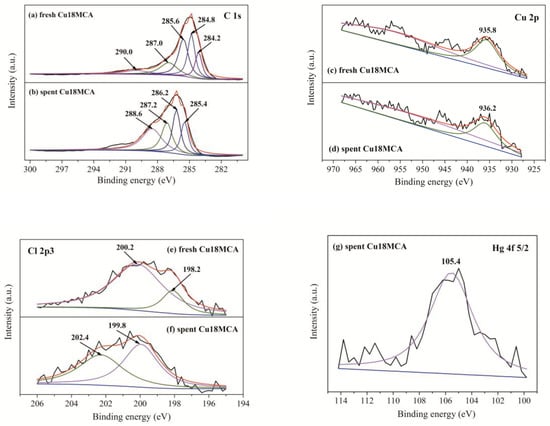
Figure 4.
X-ray photoelectron spectroscopy (XPS) spectra of (a, c, e) fresh Cu18MCA and (b, d, f, g) spent Cu18MCA.
2.2. Effect of CuCl2 Concentration
The impact of CuCl2 concentration on Hg0 adsorption performance at 120 °C is presented in Figure 5. Pristine MCA showed weaker Hg0 adsorption ability. Though the Hg0 removal efficiency could reach as high as ~88.0% within 2 min, it dropped rapidly with the time elapsed and maintained at only ~27.3% after mercury adsorption over 80 min. The probable reason is that Hg0 adsorption on MCA is a physisorption process, and the number of the active sites of MCA will be consumed during mercury adsorption process, leading to the rapid decrease in Hg0 removal efficiency. However, the Hg0 capture ability of MCA can be effectively improved by loading with CuCl2. The CuCl2-modified MCA performed well toward Hg0 adsorption, with Hg0 removal efficiency all above 96.0% due to the addition of new chemisorption sites (Cu2OCl2 and C-Cl group) [26]. The Hg0 removal efficiency of MCA significantly rose to ~97.3% and ~97.6% when CuCl2 concentrations were 0.06 mol/L and 0.18 mol/L, respectively. However, it dropped slightly to ~96.3% when CuCl2 concentration further increased from 0.18 to 0.30 mol/L. According to the nitrogen adsorption–desorption data, when CuCl2 concentration was 0.30 mol/L, BET surface area and pore volume greatly decreased thereby weakening the mercury adsorption process because excessive CuCl2 will deteriorate the pore structures of the MCA. Thus, the optimal CuCl2 concentration is 0.18 mol/L.
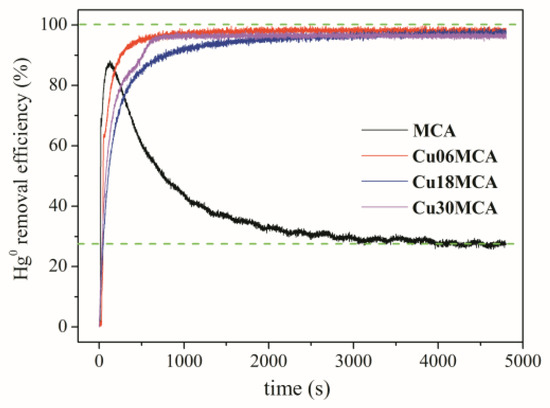
Figure 5.
Effect of CuCl2 concentration on Hg0 adsorption performance of MCA at 120 °C.
2.3. Effect of Reaction Temperature
The impact of reaction temperature on Hg0 adsorption performance of Cu18MCA is presented in Figure 6. Cu18MCA performed well toward Hg0 adsorption in the 40–160 °C temperature range, with Hg0 removal efficiency all above 95.0%, indicating that Hg0 adsorption on CuCl2-modifed MCA was mainly dominated by the chemisorption process. The Hg0 sorption rate at the initial reaction stage and the equilibrium of Hg0 removal efficiency first increased and then decreased with the reaction temperature rising from 40 to 160 °C. Cu18MCA performed the best at 80 °C with the fastest Hg0 sorption rate and the highest Hg0 removal efficiency of ~98.7%. Though higher temperatures can enhance chemisorption processes [27], the product mercury chloride will decompose at elevated temperatures, resulting in the decline of Hg0 removal efficiency. Thus, the optimal reaction temperature for Cu18MCA is 80 °C. In addition, Cu18MCA performance was fairly stable over 600 min on stream, with Hg0 removal efficiency staying above 98.0% all times (Figure 7).
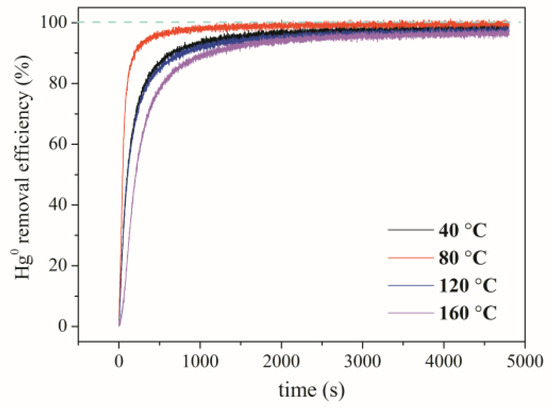
Figure 6.
Effect of reaction temperature on Hg0 adsorption performance of Cu18MCA.
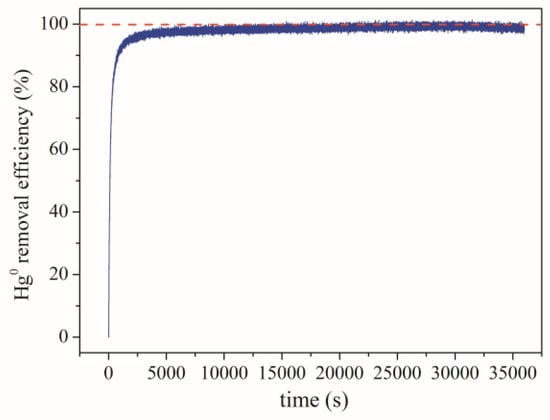
Figure 7.
Hg0 adsorption performance of Cu18MCA at 120 °C on stream over 600 min.
3. Experimental
3.1. Catalyst Synthesis and Characterization
Mesoporous carbon aerogels (MCA) were synthesized via the aqueous polymerization of resorcinol and formaldehyde [28]. CuCl2-modified MCA was fabricated via the incipient wetness impregnation method. First, certain amounts of CuCl2·2H2O were dissolved in 3.0 g of deionized water to obtain solutions with CuCl2 molar concentrations of 0.06, 0.18, and 0.30 mol/L, respectively. Then, about 1.0 g of as-prepared MCA was added into the aforementioned solution and subsequently dried at 70 °C overnight. The resultant sorbents were denoted as Cu06MCA, Cu18MCA, and Cu30MCA, respectively. The FESEM images were detected on a Phillips XL-30 FEG/NEW instrument (Eindhoven, The Netherlands). The XRD patterns were measured on Bruker D8 Advance equipment (Karlsruhe, Germany). The nitrogen isotherms were examined at 77 K on a Beishide 3H-2000PS4 apparatus (Norcross, GA, USA). The pore size distributions were estimated with the Barrett-Joyner-Halenda (BJH) method using the desorption branch of N2 isotherm, which is expressed by the Kelvin equation as follows:
where p* is the condensing pressure, p0 is the saturated vapor pressure, γ is the liquid surface tension, ν is the adsorbate molar volume, θ is the angle between the liquid and solid surface, and rm is the mean radius of curvature of the liquid meniscus. XPS analyses were carried out on a RBD upgraded PHI-5000C ESCA system (Perkin Elmer, Waltham, MA, USA) with Mg Kα radiation (hν = 1253.6 eV) or Al Kα radiation (hν = 1486.6 eV).
3.2. Mercury Adsorption
The mercury adsorption testing system has been described in detail elsewhere [29,30]. About 50 mg of sorbents were loaded into a fixed-bed reactor and heated up to the desired temperatures. Then, the nitrogen stream containing Hg0 vapor produced by a mercury generator at 50 °C was consecutively charged into the reactor. Hg0 concentration was measured by an on-line mercury analyzer (Lumex, RA-915-M, St. Petersburg, Russia). The mercury conversion can be attained by
where η denotes the mercury removal efficiency (%), and Cin and Cout denote the inlet and outlet mercury concentration (µg/m3), respectively.
η = (1 − Cout/Cin) × 100%
4. Conclusions
CuCl2-modified MCA exhibited excellent Hg0 adsorption performance in the temperature range of 40–160 °C. The Hg0 removal performance of Cu18MCA first ascended and then descended with rising reaction temperatures. It possessed the highest Hg0 removal efficiency of ~98.7% and the fastest Hg0 sorption rate at 80 °C. Chemisorption dominated the mercury adsorption process over CuCl2-modified MCA. Covalent chlorine (C-Cl groups) played a crucial role in elemental mercury adsorption process. Hg0 was first oxidized by Cu2OCl2 and captured in the form of oxidized mercury (Hg2+) and then reacted with C-Cl groups to form HgCl2.
Author Contributions
D.L. designed the experiments, analyzed the data, and wrote the paper. C.L. performed the experiments and characterized the samples. J.W. conceived the project.
Funding
This research was supported by the Fund for Senior Personnel of Jiangsu University (18JDG017) and the National Natural Science Foundation of China (21237003).
Conflicts of Interest
The authors declare no conflict of interest.
References
- Krabbenhoft, D.P.; Sunderland, E.M. Global change and mercury. Science 2013, 341, 1457–1458. [Google Scholar] [CrossRef] [PubMed]
- Reddy, B.M.; Durgasri, N.; Kumar, T.V.; Bhargava, S.K. Abatement of gas-phase mercury-recent developments. Catal. Rev. Sci. Eng. 2012, 54, 344–398. [Google Scholar] [CrossRef]
- Galbreath, K.C.; Zygarlicke, C.J. Mercury speciation in coal combustion and gasification flue gases. Environ. Sci. Technol. 1996, 30, 2421–2427. [Google Scholar] [CrossRef]
- Yang, S.; Guo, Y.; Yan, N.; Qu, Z.; Xie, J.; Yang, C.; Jia, J. Capture of gaseous elemental mercury from flue gas using a magnetic and sulfur poisoning resistant sorbent Mn/γ-Fe2O3 at lower temperatures. J. Hazard. Mater. 2011, 186, 508–515. [Google Scholar] [CrossRef] [PubMed]
- Vidic, R.D.; Siler, D.P. Vapor-phase elemental mercury adsorption by activated carbon impregnated with chloride and chelating agents. Carbon 2001, 39, 3–14. [Google Scholar] [CrossRef]
- Yang, W.; Xu, W.; Liu, Z.; Liu, Y. Removal of elemental mercury from simulated flue gas using sargassum chars modified by NH4Br reagent. Fuel 2018, 214, 196–206. [Google Scholar] [CrossRef]
- Padak, B.; Wilcox, J. Understanding mercury binding on activated carbon. Carbon 2009, 47, 2855–2864. [Google Scholar] [CrossRef]
- Xun, G.; Yao, H.; Zhang, D.; Qiao, Y.; Li, L.; Xu, M. Leaching characteristics of heavy metals in fly ash from a Chinese coal-fired power plant. Asia-Pacific J. Chem. Eng. 2010, 5, 330–336. [Google Scholar]
- Ding, F.; Zhao, Y.; Mi, L.; Li, H.; Li, Y.; Zhang, J. Removal of gas-phase elemental mercury in flue gas by inorganic chemically promoted natural mineral sorbents. Ind. Eng. Chem. Res. 2012, 51, 3039–3047. [Google Scholar] [CrossRef]
- Jampaiah, D.; Ippolito, S.J.; Sabri, Y.M.; Tardio, J.; Selvakannan, P.R.; Nafady, A.; Reddy, B.M.; Bhargava, S.K. Ceria–zirconia modified mnox catalysts for gaseous elemental mercury oxidation and adsorption. Catal. Sci. Technol. 2016, 6, 1792–1803. [Google Scholar] [CrossRef]
- Reuß, M.; Ratke, L. Subcritically dried RF-aerogels catalysed by hydrochloric acid. J. Sol–Gel Sci. Technol. 2008, 47, 74–80. [Google Scholar] [CrossRef]
- Zu, G.; Shen, J.; Zou, L.; Wang, F.; Wang, X.; Zhang, Y.; Yao, X. Nanocellulose-derived highly porous carbon aerogels for super capacitors. Carbon 2016, 99, 203–211. [Google Scholar] [CrossRef]
- Liu, Z.; Li, X.; Lee, J.Y.; Bolin, T.B. Oxidation of elemental mercury vapor over γ-Al2O3 supported CuCl2 catalyst for mercury emissions control. Chem. Eng. J. 2015, 275, 1–7. [Google Scholar] [CrossRef]
- Yang, J.; Zhao, Y.; Zhang, J.; Zheng, C. Removal of elemental mercury from flue gas by recyclable CuCl2 modified magnetospheres catalyst from fly ash. Part 1. Catalyst characterization and performance evaluation. Fuel 2016, 164, 419–428. [Google Scholar] [CrossRef]
- Zhou, Z.; Liu, X.; Hu, Y.; Liao, Z.; Cheng, S.; Xu, M. An efficient sorbent based on CuCl2 loaded CeO2-ZrO2 for elemental mercury removal from chlorine-free flue gas. Fuel 2018, 216, 356–363. [Google Scholar] [CrossRef]
- Sevilla, M.; Sanchís, C.; Valdés-Solís, T.; Morallón, E.; Fuertes, A.B. Direct synthesis of graphitic carbon nanostructures from saccharides and their use as electrocatalytic supports. Carbon 2008, 46, 931–939. [Google Scholar] [CrossRef]
- Wu, D.; Fu, R.; Yu, Z. Organic and carbon aerogels from the NaOH-catalyzed polycondensation of resorcinol-furfural and supercritical drying in ethanol. J. Appl. Polym. Sci. 2005, 96, 1429–1435. [Google Scholar] [CrossRef]
- Rasines, G.; Lavela, P.; Macı´as, C.; Zafra, M.C.; Tirado, J.L.; Parra, J.B.; Ania, C.O. N-doped monolithic carbon aerogel electrodes with optimized features for the electrosorption of ions. Carbon 2015, 83, 262–274. [Google Scholar] [CrossRef]
- Yang, G.; Han, H.; Li, T.; Du, C. Synthesis of nitrogen-doped porous graphitic carbons using nano-CaCO3 as template, graphitization catalyst and activating agent. Carbon 2012, 50, 3752–3765. [Google Scholar] [CrossRef]
- Li, X.; Liu, Z.; Kim, J.; Lee, J.-Y. Heterogeneous catalytic reaction of elemental mercury vapor over cupric chloride for mercury emissions control. Appl. Catal. B Environ. 2013, 132–133, 401–407. [Google Scholar] [CrossRef]
- Yang, J.; Zhao, Y.; Zhang, J.; Zheng, C. Removal of elemental mercury from flue gas by recyclable CuCl2 modified magnetospheres catalyst from fly ash: Part 2. Identification of involved reaction mechanism. Fuel 2016, 167, 366–374. [Google Scholar] [CrossRef]
- Xu, H.; Qu, Z.; Zong, C.; Zong, C.; Huang, W.; Quan, F.; Yan, N. MnOx/Graphene for the catalytic oxidation and adsorption of elemental mercury. Environ. Sci. Technol. 2015, 49, 6823–6830. [Google Scholar] [CrossRef] [PubMed]
- Tao, S.; Li, C.; Fan, X.; Zeng, G.; Lu, P.; Zhang, X.; Wen, Q.; Zhao, W.; Luo, D.; Fan, C. Activated coke impregnated with cerium chloride used for elemental mercury removal from simulated flue gas. Chem. Eng. J. 2012, 210, 547–556. [Google Scholar] [CrossRef]
- Tan, Z.; Sun, L.; Xiang, J.; Zeng, H.; Liu, Z.; Hu, S.; Qiu, J. Gas-phase elemental mercury removal by novel carbon-based sorbents. Carbon 2012, 50, 362–371. [Google Scholar] [CrossRef]
- Yang, W.; Shan, Y.; Ding, S.; Han, X.; Liu, Y.; Pan, J. Gas-phase elemental mercury removal using ammonium chloride impregnated sargassum chars. Environ. Technol. 2018, 1, 1–14. [Google Scholar] [CrossRef] [PubMed]
- Zhou, J.; Liu, Y.; Pan, J. Removal of elemental mercury from flue gas using wheat straw chars modified by K2FeO4 Reagent. Environ. Technol. 2017, 38, 3047–3054. [Google Scholar] [CrossRef] [PubMed]
- Lee, S.J.; Seo, Y.C.; Jurng, J.; Tai, G.L. Removal of gas-phase elemental mercury by iodine- and chlorine-impregnated activated carbons. Atmos. Environ. 2004, 38, 4887–4893. [Google Scholar] [CrossRef]
- Wu, J.; Yang, S.; Liu, Q.; He, P.; Tian, H.; Ren, J.; Guan, Z.; Hu, T.; Ni, B.; Zhang, C. Cu Nanoparticles inlaid mesoporous carbon aerogels as a high performance desulfurizer. Environ. Sci. Technol. 2016, 50, 5370–5378. [Google Scholar] [CrossRef]
- Liu, D.J.; Zhou, W.G.; Wu, J. Effect of Ce and La on the activity of CuO/ZSM-5 and MnOx/ZSM-5 composites for elemental mercury removal at low temperature. Fuel 2017, 194, 115–122. [Google Scholar] [CrossRef]
- Liu, D.J.; Lu, C.; Wu, J. Gaseous mercury capture by copper-activated nanoporous carbon nitride. Energy Fuels 2018, 32, 8287–8295. [Google Scholar] [CrossRef]
Sample Availability: Samples of the compounds are not available from the authors. |
© 2018 by the authors. Licensee MDPI, Basel, Switzerland. This article is an open access article distributed under the terms and conditions of the Creative Commons Attribution (CC BY) license (http://creativecommons.org/licenses/by/4.0/).